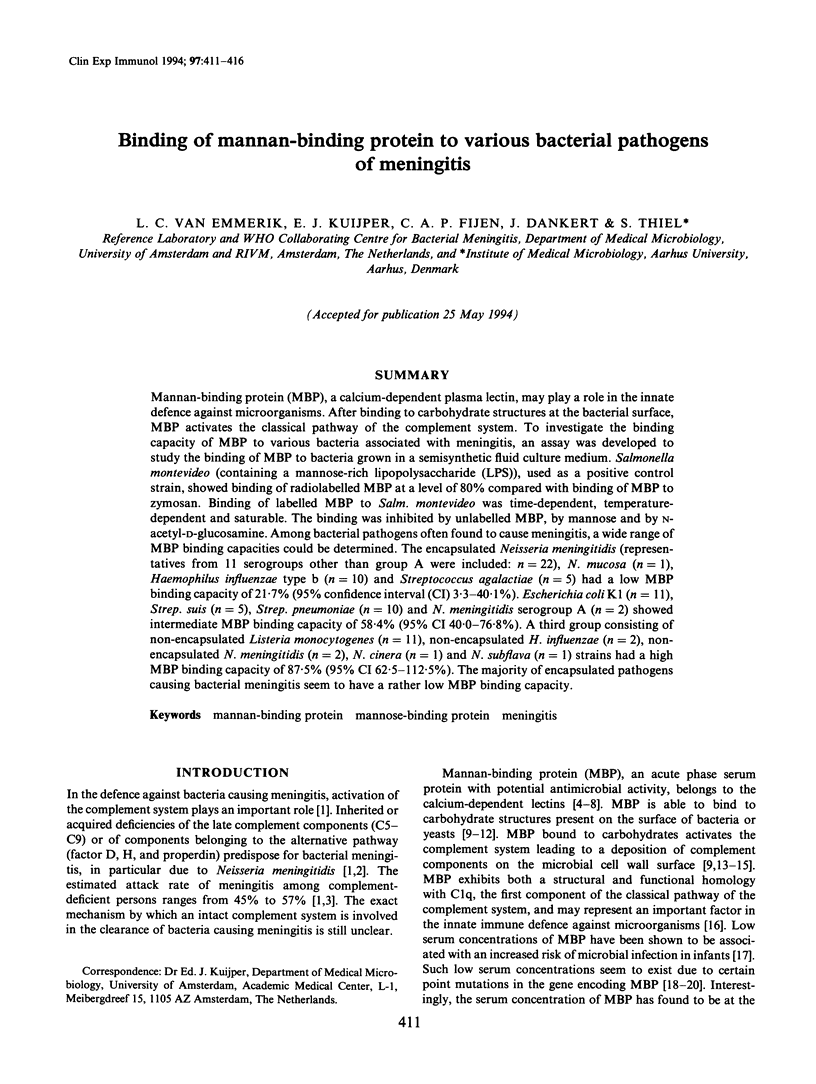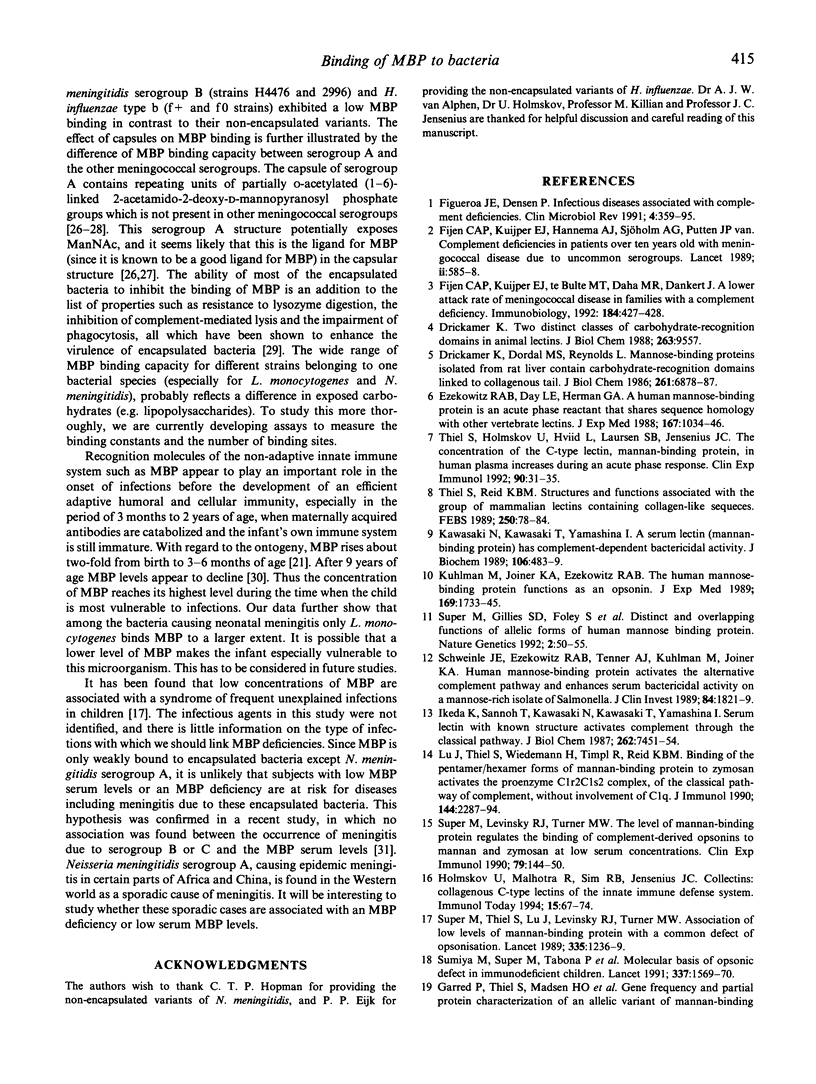Abstract
Mannan-binding protein (MBP), a calcium-dependent plasma lectin, may play a role in the innate defence against microorganisms. After binding to carbohydrate structures at the bacterial surface, MBP activates the classical pathway of the complement system. To investigate the binding capacity of MBP to various bacteria associated with meningitis, an assay was developed to study the binding of MBP to bacteria grown in a semisynthetic fluid culture medium. Salmonella montevideo (containing a mannose-rich lipopolysaccharide (LPS)), used as a positive control strain, showed binding of radiolabelled MBP at a level of 80% compared with binding of MBP to zymosan. Binding of labelled MBP to Salm. montevideo was time-dependent, temperature-dependent and saturable. The binding was inhibited by unlabelled MBP, by mannose and by N-acetyl-D-glucosamine. Among bacterial pathogens often found to cause meningitis, a wide range of MBP binding capacities could be determined. The encapsulated Neisseria meningitidis (representatives from 11 serogroups other than group A were included: n = 22), N. mucosa (n = 1), Haemophilus influenzae type b (n = 10) and Streptococcus agalactiae (n = 5) had a low MBP binding capacity of 21.7% (95% confidence interval (CI) 3.3-40.1%). Escherichia coli K1 (n = 11), Strep. suis (n = 5), Strep. pneumoniae (n = 10) and N. meningitidis serogroup A (n = 2) showed intermediate MBP binding capacity of 58.4% (95% CI 40.0-76.8%). A third group consisting of non-encapsulated Listeria monocytogenes (n = 11), non-encapsulated H. influenzae (n = 2), non-encapsulated N. meningitidis (n = 2), N. cinera (n = 1) and N. subflava (n = 1) strains had a high MBP binding capacity of 87.5% (95% CI 62.5-112.5%). The majority of encapsulated pathogens causing bacterial meningitis seem to have a rather low MBP binding capacity.
Full text
PDF





Images in this article
Selected References
These references are in PubMed. This may not be the complete list of references from this article.
- Bundle D. R., Smith I. C., Jennings H. J. Determination of the structure and conformation of bacterial polysaccharides by carbon 13 nuclear magnetic resonance. Studies on the group-specific antigens of Neisseria meningitidis serogroups A and X. J Biol Chem. 1974 Apr 10;249(7):2275–2281. [PubMed] [Google Scholar]
- DeVoe I. W. The meningococcus and mechanisms of pathogenicity. Microbiol Rev. 1982 Jun;46(2):162–190. doi: 10.1128/mr.46.2.162-190.1982. [DOI] [PMC free article] [PubMed] [Google Scholar]
- Drickamer K., Dordal M. S., Reynolds L. Mannose-binding proteins isolated from rat liver contain carbohydrate-recognition domains linked to collagenous tails. Complete primary structures and homology with pulmonary surfactant apoprotein. J Biol Chem. 1986 May 25;261(15):6878–6887. [PubMed] [Google Scholar]
- Drickamer K. Two distinct classes of carbohydrate-recognition domains in animal lectins. J Biol Chem. 1988 Jul 15;263(20):9557–9560. [PubMed] [Google Scholar]
- Ezekowitz R. A., Day L. E., Herman G. A. A human mannose-binding protein is an acute-phase reactant that shares sequence homology with other vertebrate lectins. J Exp Med. 1988 Mar 1;167(3):1034–1046. doi: 10.1084/jem.167.3.1034. [DOI] [PMC free article] [PubMed] [Google Scholar]
- Figueroa J. E., Densen P. Infectious diseases associated with complement deficiencies. Clin Microbiol Rev. 1991 Jul;4(3):359–395. doi: 10.1128/cmr.4.3.359. [DOI] [PMC free article] [PubMed] [Google Scholar]
- Fijen C. A., Kuijper E. J., Hannema A. J., Sjöholm A. G., van Putten J. P. Complement deficiencies in patients over ten years old with meningococcal disease due to uncommon serogroups. Lancet. 1989 Sep 9;2(8663):585–588. doi: 10.1016/s0140-6736(89)90712-5. [DOI] [PubMed] [Google Scholar]
- Fornstedt N., Porath J. Characterization studies on a new lectin found in seeds of Vicia ervilia. FEBS Lett. 1975 Sep 15;57(2):187–191. doi: 10.1016/0014-5793(75)80713-7. [DOI] [PubMed] [Google Scholar]
- Fraker P. J., Speck J. C., Jr Protein and cell membrane iodinations with a sparingly soluble chloroamide, 1,3,4,6-tetrachloro-3a,6a-diphrenylglycoluril. Biochem Biophys Res Commun. 1978 Feb 28;80(4):849–857. doi: 10.1016/0006-291x(78)91322-0. [DOI] [PubMed] [Google Scholar]
- Garred P., Michaelsen T. E., Bjune G., Thiel S., Svejgaard A. A low serum concentration of mannan-binding protein is not associated with serogroup B or C meningococcal disease. Scand J Immunol. 1993 Apr;37(4):468–470. doi: 10.1111/j.1365-3083.1993.tb03320.x. [DOI] [PubMed] [Google Scholar]
- Garred P., Thiel S., Madsen H. O., Ryder L. P., Jensenius J. C., Svejgaard A. Gene frequency and partial protein characterization of an allelic variant of mannan binding protein associated with low serum concentrations. Clin Exp Immunol. 1992 Dec;90(3):517–521. doi: 10.1111/j.1365-2249.1992.tb05876.x. [DOI] [PMC free article] [PubMed] [Google Scholar]
- Holmskov U., Malhotra R., Sim R. B., Jensenius J. C. Collectins: collagenous C-type lectins of the innate immune defense system. Immunol Today. 1994 Feb;15(2):67–74. doi: 10.1016/0167-5699(94)90136-8. [DOI] [PubMed] [Google Scholar]
- Ihara I., Harada Y., Ihara S., Kawakami M. A new complement-dependent bactericidal factor found in nonimmune mouse sera: specific binding to polysaccharide of Ra chemotype Salmonella. J Immunol. 1982 Mar;128(3):1256–1260. [PubMed] [Google Scholar]
- Ikeda K., Sannoh T., Kawasaki N., Kawasaki T., Yamashina I. Serum lectin with known structure activates complement through the classical pathway. J Biol Chem. 1987 Jun 5;262(16):7451–7454. [PubMed] [Google Scholar]
- Kawasaki N., Kawasaki T., Yamashina I. A serum lectin (mannan-binding protein) has complement-dependent bactericidal activity. J Biochem. 1989 Sep;106(3):483–489. doi: 10.1093/oxfordjournals.jbchem.a122878. [DOI] [PubMed] [Google Scholar]
- Kuhlman M., Joiner K., Ezekowitz R. A. The human mannose-binding protein functions as an opsonin. J Exp Med. 1989 May 1;169(5):1733–1745. doi: 10.1084/jem.169.5.1733. [DOI] [PMC free article] [PubMed] [Google Scholar]
- Laemmli U. K. Cleavage of structural proteins during the assembly of the head of bacteriophage T4. Nature. 1970 Aug 15;227(5259):680–685. doi: 10.1038/227680a0. [DOI] [PubMed] [Google Scholar]
- Lipscombe R. J., Sumiya M., Hill A. V., Lau Y. L., Levinsky R. J., Summerfield J. A., Turner M. W. High frequencies in African and non-African populations of independent mutations in the mannose binding protein gene. Hum Mol Genet. 1992 Dec;1(9):709–715. doi: 10.1093/hmg/1.9.709. [DOI] [PubMed] [Google Scholar]
- Liu T. Y., Gotschlich E. C., Jonssen E. K., Wysocki J. R. Studies on the meningococcal polysaccharides. I. Composition and chemical properties of the group A polysaccharide. J Biol Chem. 1971 May 10;246(9):2849–2858. [PubMed] [Google Scholar]
- Lu J. H., Thiel S., Wiedemann H., Timpl R., Reid K. B. Binding of the pentamer/hexamer forms of mannan-binding protein to zymosan activates the proenzyme C1r2C1s2 complex, of the classical pathway of complement, without involvement of C1q. J Immunol. 1990 Mar 15;144(6):2287–2294. [PubMed] [Google Scholar]
- Moxon E. R., Kroll J. S. The role of bacterial polysaccharide capsules as virulence factors. Curr Top Microbiol Immunol. 1990;150:65–85. doi: 10.1007/978-3-642-74694-9_4. [DOI] [PubMed] [Google Scholar]
- Schweinle J. E., Ezekowitz R. A., Tenner A. J., Kuhlman M., Joiner K. A. Human mannose-binding protein activates the alternative complement pathway and enhances serum bactericidal activity on a mannose-rich isolate of Salmonella. J Clin Invest. 1989 Dec;84(6):1821–1829. doi: 10.1172/JCI114367. [DOI] [PMC free article] [PubMed] [Google Scholar]
- Sumiya M., Super M., Tabona P., Levinsky R. J., Arai T., Turner M. W., Summerfield J. A. Molecular basis of opsonic defect in immunodeficient children. Lancet. 1991 Jun 29;337(8757):1569–1570. doi: 10.1016/0140-6736(91)93263-9. [DOI] [PubMed] [Google Scholar]
- Super M., Gillies S. D., Foley S., Sastry K., Schweinle J. E., Silverman V. J., Ezekowitz R. A. Distinct and overlapping functions of allelic forms of human mannose binding protein. Nat Genet. 1992 Sep;2(1):50–55. doi: 10.1038/ng0992-50. [DOI] [PubMed] [Google Scholar]
- Super M., Levinsky R. J., Turner M. W. The level of mannan-binding protein regulates the binding of complement-derived opsonins to mannan and zymosan at low serum concentrations. Clin Exp Immunol. 1990 Feb;79(2):144–150. doi: 10.1111/j.1365-2249.1990.tb05170.x. [DOI] [PMC free article] [PubMed] [Google Scholar]
- Super M., Thiel S., Lu J., Levinsky R. J., Turner M. W. Association of low levels of mannan-binding protein with a common defect of opsonisation. Lancet. 1989 Nov 25;2(8674):1236–1239. doi: 10.1016/s0140-6736(89)91849-7. [DOI] [PubMed] [Google Scholar]
- Terai I., Kobayashi K., Fujita T., Hagiwara K. Human serum mannose binding protein (MBP): development of an enzyme-linked immunosorbent assay (ELISA) and determination of levels in serum from 1085 normal Japanese and in some body fluids. Biochem Med Metab Biol. 1993 Aug;50(1):111–119. doi: 10.1006/bmmb.1993.1052. [DOI] [PubMed] [Google Scholar]
- Thiel S., Holmskov U., Hviid L., Laursen S. B., Jensenius J. C. The concentration of the C-type lectin, mannan-binding protein, in human plasma increases during an acute phase response. Clin Exp Immunol. 1992 Oct;90(1):31–35. doi: 10.1111/j.1365-2249.1992.tb05827.x. [DOI] [PMC free article] [PubMed] [Google Scholar]
- Thiel S., Reid K. B. Structures and functions associated with the group of mammalian lectins containing collagen-like sequences. FEBS Lett. 1989 Jun 19;250(1):78–84. doi: 10.1016/0014-5793(89)80689-1. [DOI] [PubMed] [Google Scholar]



